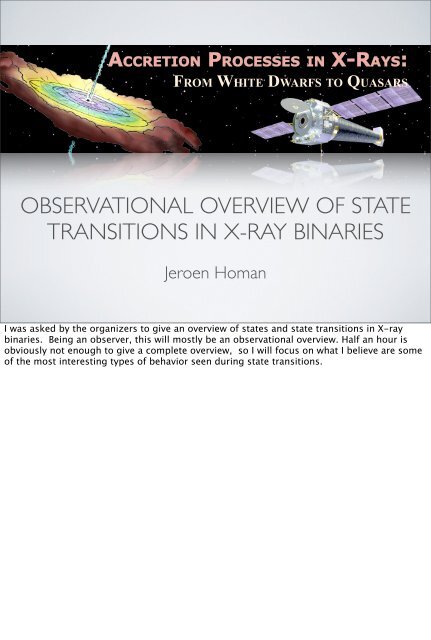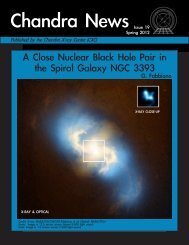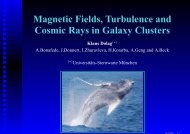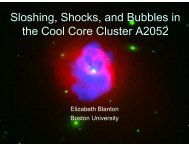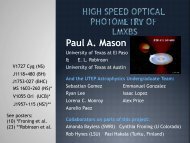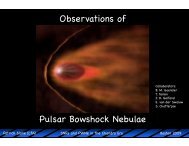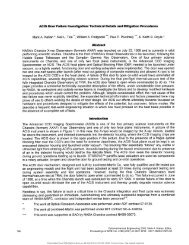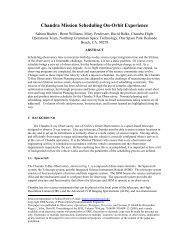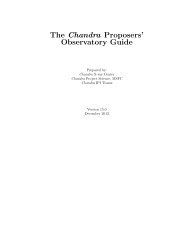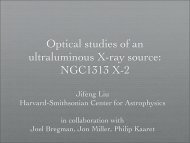observational overview of state transitions in x-ray binaries
observational overview of state transitions in x-ray binaries
observational overview of state transitions in x-ray binaries
Create successful ePaper yourself
Turn your PDF publications into a flip-book with our unique Google optimized e-Paper software.
!""#$%&'()*#'"$++$+)&(),-#!.+/<br />
4566789( :;6?@76A6B7@( CD5;<br />
9B>8BE7F(9C7(@95F=(>G(8(B8(FBA76@7(IC=@BH
BACKGROUND<br />
• Known s<strong>in</strong>ce the 1970’s that X-<strong>ray</strong> b<strong>in</strong>aries can show different<br />
spectral <strong>state</strong>s (Cyg X-1, Tananbaum et al. 1972).<br />
• Reflect different modes <strong>of</strong> accretion (<strong>in</strong>flow/outflow)<br />
• mid 1980‘s - early 1990’s: EXOSAT and GINGA. Additional<br />
<strong>state</strong>s identified <strong>in</strong> black hole b<strong>in</strong>aries. Z and atoll classification<br />
for neutron star b<strong>in</strong>aries.<br />
• State dependency <strong>of</strong> rapid X-<strong>ray</strong> variability and radio emission<br />
Let me first start with a little background. Observations <strong>of</strong> the black hole X-<strong>ray</strong> b<strong>in</strong>ary Cyg<br />
X-1 <strong>in</strong> the early 70’s showed that it displayed two dist<strong>in</strong>ct spectral <strong>state</strong>s; a high lum<strong>in</strong>osity<br />
<strong>state</strong> with a s<strong>of</strong>t, thermal X-<strong>ray</strong> spectrum without radio emission, and a low-lum<strong>in</strong>osity <strong>state</strong><br />
with a hard, non-thermal spectrum accompanied with radio emission. The spectral <strong>state</strong>s are<br />
now thought to reflect different modes <strong>of</strong> accretion onto a compact object.<br />
Observations between the mid 80s and early 90‘s with EXOSAT and G<strong>in</strong>ga revealed additional<br />
spectral <strong>state</strong>s <strong>in</strong> black hole X-<strong>ray</strong> b<strong>in</strong>aires and also dist<strong>in</strong>ct spectral <strong>state</strong>s <strong>in</strong> neutron star<br />
sources (with the identification <strong>of</strong> the so-called Z and atoll sources). We also saw the first<br />
<strong>in</strong>dications for a spectral <strong>state</strong> dependency <strong>of</strong> the rapid X-<strong>ray</strong> variability and radio emission.<br />
For the rest <strong>of</strong> the talk I will simply refer to spectral <strong>state</strong>s as <strong>state</strong>s, s<strong>in</strong>ce it is not only the<br />
spectral properties that change.
MORE<br />
BACKGROUND<br />
• 1996>: Dedicated monitor<strong>in</strong>g programs with Rossi X-<strong>ray</strong><br />
Tim<strong>in</strong>g Explorer. Major progress.<br />
• SAX/Chandra/XMM/Suzaku/INTEGRAL are complet<strong>in</strong>g the<br />
X-<strong>ray</strong> picture.<br />
• Radio and nIR monitor<strong>in</strong>g greatly expanded. Studies <strong>of</strong> jets.<br />
• L<strong>in</strong>ks with AGN / ULX<br />
Major progress <strong>in</strong> our understand<strong>in</strong>g <strong>of</strong> <strong>state</strong>s was made after the launch <strong>of</strong> the Rossi X-<strong>ray</strong><br />
Tim<strong>in</strong>g Explorer, which performed many dedicated monitor<strong>in</strong>g campaigns <strong>of</strong> transient and<br />
highly variably sources. This was important to establish the relation between the various<br />
<strong>state</strong>s.<br />
It also provided a strong framework for observations with satellites that provide <strong>in</strong>formation<br />
that cannot be obta<strong>in</strong>ed with RXTE, most notably high resolution spectra to study w<strong>in</strong>ds and<br />
outflows, low energy coverage to study disk evolution, broader energy range, and highenergy<br />
coverage.<br />
The last decade has also seen an large <strong>in</strong>crease <strong>in</strong> radio and nIR observations that allow<br />
studies <strong>of</strong> jet outflows. Together these observations are complet<strong>in</strong>g our picture <strong>of</strong> <strong>state</strong>s and<br />
<strong>state</strong> <strong>transitions</strong>, at least <strong>in</strong> an <strong>observational</strong> sense, and allows for a better <strong>in</strong>terpretation <strong>of</strong><br />
the underly<strong>in</strong>g changes <strong>in</strong> the accretion flow.<br />
Although I will not discuss the topic <strong>in</strong> my talk, observations <strong>of</strong> <strong>state</strong>s <strong>in</strong> black hole X-<strong>ray</strong><br />
b<strong>in</strong>aries are also relavant to the study <strong>of</strong> AGN, as we heard earlier today, and also that <strong>of</strong><br />
ULXs.
• black hole transients<br />
• light curves, hardness-<strong>in</strong>tensity diagrams (HID)<br />
• implications for accretion flows<br />
• black hole <strong>state</strong>s (classification)<br />
• variability (quasi-periodic oscillations - QPOs)<br />
• jets, w<strong>in</strong>ds - relation to <strong>state</strong>s<br />
• neutron star transients<br />
OUTLINE<br />
Here’s a brief outl<strong>in</strong>e <strong>of</strong> the talk. Most <strong>of</strong> my talk will deal with black hole systems, as our<br />
knowledge <strong>of</strong> the different <strong>state</strong>s appears to be a bit more complete. I’ll start with an<br />
<strong>overview</strong> <strong>of</strong> transient outbursts and will <strong>in</strong>troduce the hardness-<strong>in</strong>tensity diagram, which is<br />
useful tool to study the spectral evolution <strong>of</strong> transients. I’ll discuss some <strong>of</strong> the implications<br />
<strong>of</strong> the observed evolution for accretion flows. I’ll go on to identify the various <strong>state</strong>s <strong>in</strong> the<br />
HID and summarize their spectral and variability properties.<br />
I’ll cont<strong>in</strong>ue by show<strong>in</strong>g how the different types <strong>of</strong> variability map onto the hardness <strong>in</strong>tensity<br />
diagram. I will do the same for jets and w<strong>in</strong>ds.<br />
I’ll end with a brief comparison with neutron stars, where a lot <strong>of</strong> progress has been made<br />
recently.
TRANSIENT SOURCES<br />
• Relation between different <strong>state</strong>s is best studied <strong>in</strong> transient<br />
(or highly variable) sources:<br />
• large change <strong>in</strong> mass accretion rate<br />
• Monitor<strong>in</strong>g with RXTE has been very valuable<br />
For my discussion <strong>of</strong> <strong>state</strong>s I'll limit myself to transient sources. These<br />
sources undergo large changes <strong>in</strong> the mass accretion rates dur<strong>in</strong>g their<br />
outbursts, as the result <strong>of</strong> which they makes <strong>transitions</strong> between several<br />
<strong>state</strong>s.<br />
Almost all observations that I will present today are from RXTE, which<br />
has been able to monitor the outbursts <strong>of</strong> tens <strong>of</strong> transients <strong>in</strong> great<br />
detail. Moreover, it gives two <strong>of</strong> the key <strong>in</strong>gredients necessary for<br />
classify<strong>in</strong>g observations: broadband spectra and rapid variability
LONG-TERM LIGHT CURVES<br />
4U 1543-47<br />
GRO J1655-40<br />
RXTE All-Sky Monitor<br />
H1743-332<br />
GX 339-4<br />
Here I show a few examples <strong>of</strong> long-term light curves from the All-Sky monitor on RXTE. As<br />
you can see there is quite a variety <strong>in</strong> the duty cycle <strong>of</strong> these systems and also <strong>in</strong> the length<br />
and brightness <strong>of</strong> the outbursts <strong>of</strong> <strong>in</strong>dividual sources. The general consensus is the longterm<br />
transient behavior is the result <strong>of</strong> <strong>in</strong>stabilities <strong>in</strong> the outer disk, just as <strong>in</strong> dwarf novae.
OUTBURST LIGHT CURVES<br />
4U 1543-47<br />
GRO J1655-40<br />
RXTE/PCA<br />
GX 339-4<br />
H1743-322<br />
Here I show a few examples <strong>of</strong> <strong>in</strong>dividual outbursts as observed with the RXTE/PCA. The large<br />
variety <strong>in</strong> outburst shapes is obvious. Outbursts typically last from a few weeks to a year.<br />
Some show a very fast rise to their peak, while <strong>in</strong> other sources it is much slower. Others<br />
show multiple peaks or very irregular shapes. Strong flar<strong>in</strong>g, like shown here <strong>in</strong> GRO<br />
J1655-40 and H1743-322, is typically only seen <strong>in</strong> the brightest outbursts, which go above,<br />
say 20% Edd<strong>in</strong>gton.
LIGHT CURVE<br />
GX 339-4<br />
Let me illustrate the typical spectral evolution that is seen <strong>in</strong> most transient outburst. I’m<br />
tak<strong>in</strong>g GX 339-4 as an example, as it show fairly clean behavior, compared to some other<br />
systems. This is a light curve <strong>in</strong> the full RXTE/PCA energy band
ENERGY DEPENDENCE<br />
This movie (Homan_GX339-4_movie.mov) shows how the outburst shape depends on energy.<br />
Dur<strong>in</strong>g the movie the energy <strong>of</strong> the light curve goes down from 20 keV to 2 keV. In the high<br />
energy band we see a large peak at the start <strong>of</strong> the outburst. Go<strong>in</strong>g down to lower energies<br />
that peak disappears. Instead we see peaks appear later <strong>in</strong> the<br />
outburst. Obviously, there are considerable spectral changes dur<strong>in</strong>g the outburst.
SPECTRAL EVOLUTION<br />
GX 339-4<br />
Let me go back to the full band light curve aga<strong>in</strong> and discuss <strong>in</strong> more<br />
detail the spectral (or color) evolution dur<strong>in</strong>g an outburst
SPECTRAL EVOLUTION<br />
GX 339-4<br />
First I’ll switch to a logarithmic scale for the outburst, s<strong>in</strong>ce some spectral evolution takes<br />
place at the lowest count rates. This way it is more convenient to get a look at changes at all<br />
lum<strong>in</strong>osity levels
COLOR EVOLUTION<br />
hard s<strong>of</strong>t<br />
hardest = power-law com<strong>in</strong>ated (<strong>in</strong>dex 1.5)<br />
s<strong>of</strong>test = accretion disk dom<strong>in</strong>ated (1 keV)<br />
GX 339-4<br />
hard<br />
hardness = 10.0-20.0 keV / 3.0-5.0 keV<br />
The next panel I’m add<strong>in</strong>g shows the evolution <strong>of</strong> the spectral hardness, which is a simple<br />
ratio <strong>of</strong> count rates <strong>in</strong> two energy bands, <strong>in</strong> this case the 10-20 keV and 3.0/5.0 keV. It<br />
shows that the outburst starts with the source hav<strong>in</strong>g a hard spectrum, switch<strong>in</strong>g to a s<strong>of</strong>t<br />
spectrum, and at the end back to a hard spectrum. In this case the hardest spectra<br />
correspond to power-law dom<strong>in</strong>ated spectra, with an <strong>in</strong>dex <strong>of</strong> around 1.5, while the s<strong>of</strong>test<br />
ones are accretion disk dom<strong>in</strong>ated, with a typical temperature <strong>of</strong> 1 keV. Note that the<br />
behavior seen <strong>in</strong> other black hole transients is mostly consistent with this, i.e. go<strong>in</strong>g from<br />
hard to s<strong>of</strong>t and back to hard. By comb<strong>in</strong><strong>in</strong>g these two curves <strong>in</strong>to a hardness-<strong>in</strong>tensity<br />
diagram, we can see how this spectral evolution occurs as a function <strong>of</strong> the overall <strong>in</strong>tensity<br />
level.
COLOR EVOLUTION<br />
hardness-<strong>in</strong>tensity diagram (HID)<br />
Here is the HID that is the result <strong>of</strong> comb<strong>in</strong><strong>in</strong>g the light and hardness curves I just showed.<br />
The HID is a diagnostic plot<br />
that is used extensively <strong>in</strong> <strong>in</strong>terpret<strong>in</strong>g the X-<strong>ray</strong> evolution <strong>of</strong> black hole and neutron star X<strong>ray</strong><br />
b<strong>in</strong>aries.<br />
As a function <strong>of</strong> time, GX 339-4 traces out a q-shaped track dur<strong>in</strong>g its bright outbursts. The<br />
branches that are shown correspond to different spectral <strong>state</strong>s or <strong>transitions</strong> between them.
SPECTRAL EVOLUTION<br />
hardness-<strong>in</strong>tensity diagram (HID)<br />
The arrows <strong>in</strong>dicate the evolution <strong>in</strong> time. The source starts out fa<strong>in</strong>t and hard and <strong>in</strong>creases<br />
<strong>in</strong> lum<strong>in</strong>osity while the spectrum rema<strong>in</strong>s hard. At some po<strong>in</strong>t a sudden s<strong>of</strong>ten<strong>in</strong>g <strong>of</strong> the<br />
spectrum takes place, with only m<strong>in</strong>or changes <strong>in</strong> the count rate. The spectrum rema<strong>in</strong>s s<strong>of</strong>t<br />
as the source decays, but at some po<strong>in</strong>t the spectrum shows a sudden harden<strong>in</strong>g and returns<br />
to the same hardness as at the start <strong>of</strong> the outburst. For the rema<strong>in</strong>der <strong>of</strong> the decay the<br />
spectrum rema<strong>in</strong>s hard. The q-shaped diagram is traced out <strong>in</strong> an anti-clockwise manner.<br />
There are two important aspect <strong>of</strong> this diagram that should be noted.<br />
First, while at low lum<strong>in</strong>osities the spectrum is always hard, at higher lum<strong>in</strong>osities, the<br />
spectrum can be hard, s<strong>of</strong>t, or <strong>of</strong> <strong>in</strong>termediate hardness.<br />
Second, the transition from hard to s<strong>of</strong>t takes place at a significantly higher lum<strong>in</strong>osity than<br />
the reverse transition.<br />
Similar behavior is also seen <strong>in</strong> other sources, as I will show later.
Lum<strong>in</strong>osity (erg/s)<br />
SPECTRAL EVOLUTION<br />
ux<br />
hardness<br />
1-<br />
Disk Fraction<br />
Dunn et al. 2010<br />
Alternative ways to trace the evolution that actually <strong>in</strong>volve some spectral fitt<strong>in</strong>g, produce<br />
similar look<strong>in</strong>g diagrams. Here I’m show<strong>in</strong>g a figure taken from a paper by Dunn et al. It<br />
show a so-called disk-fraction-lum<strong>in</strong>osity diagram, where disk fraction is def<strong>in</strong>ed as the ratio<br />
<strong>of</strong> disk flux and total flux. It is useful to compare outbursts <strong>of</strong> different sources, but it<br />
requires a lot more work and is less sensitive to subtle changes. For comparison they show<br />
how certa<strong>in</strong> selected observations <strong>in</strong> a HID map onto such a diagram - it clearly show the<br />
limitation to constra<strong>in</strong> disk fraction with RXTE, which is the reason I prefer to stick with the<br />
HID.
XTE J1752-223<br />
XTE J1908+094<br />
SPECTRAL EVOLUTION<br />
XTE J1650-500<br />
XTE J1550-564<br />
Here are four outburst from other sources. In three <strong>of</strong> them the rise <strong>of</strong> the outburst was not<br />
fully covered, but the behavior is consistent with what we saw <strong>in</strong> GX 339-4.
XTE J1752-223<br />
XTE J1908+094<br />
SPECTRAL EVOLUTION<br />
XTE J1650-500<br />
XTE J1550-564<br />
Aga<strong>in</strong>, q-shaped diagrams are traced out <strong>in</strong> and anti-clockwise manner. Note that this anticlockwise<br />
behavior is seen <strong>in</strong> almost all transients. The five HIDs I’ve showed so far are all<br />
from outburst <strong>in</strong> which no flar<strong>in</strong>g was present. Let’s take a look at an outburst that does<br />
show flar<strong>in</strong>g, s<strong>in</strong>ce it shows some additional behavior.
SPECTRAL EVOLUTION<br />
GRO J1655-40<br />
Here is a light curve <strong>of</strong> GRO J1655-40, which shows clear flar<strong>in</strong>g, with large changes <strong>in</strong> the<br />
count rate on a time scale <strong>of</strong> a day.
SPECTRAL EVOLUTION<br />
GRO J1655-40<br />
I’ll switch to a log scale aga<strong>in</strong>, which makes the flar<strong>in</strong>g it little less impressive, but reveals<br />
more detail at low count rates.
SPECTRAL EVOLUTION<br />
hard<br />
GRO J1655-40<br />
And here I’m add<strong>in</strong>g the hardness evolution. We still see the ma<strong>in</strong> hard -> s<strong>of</strong>t -> hard<br />
<strong>transitions</strong>, but the behavior around the time <strong>of</strong> the flar<strong>in</strong>g actually shows some changes <strong>in</strong><br />
hardness as well. Let’s see what the HID looks like.<br />
s<strong>of</strong>t<br />
hard
SPECTRAL EVOLUTION<br />
GRO J1655-40<br />
We still see a roughly q-shaped diagram, but on top <strong>of</strong> it we see some additional structure<br />
that corresponds to the flar<strong>in</strong>g, and as I will show <strong>in</strong> a few m<strong>in</strong>utes, this additional branch<br />
corresponds to a dist<strong>in</strong>ct spectral <strong>state</strong>.
SPECTRAL EVOLUTION<br />
GRO J1655-40 H1743-322<br />
XTE J1859+226<br />
brighter outburst: additional structure<br />
Here I show additional HIDs, which also show additional back and forth motion at their<br />
highest count rates, aga<strong>in</strong> correspond<strong>in</strong>g to flar<strong>in</strong>g <strong>in</strong> the light curve.
SPECTRAL EVOLUTION<br />
GX 339-4<br />
Transitions at<br />
different<br />
lum<strong>in</strong>osities<br />
XTE 1550-564<br />
Not always full<br />
<strong>transitions</strong><br />
Flar<strong>in</strong>g only at<br />
high lum<strong>in</strong>osity<br />
GRO J1655-40<br />
Flar<strong>in</strong>g at similar<br />
lum<strong>in</strong>osity<br />
The HIDs I showed until now were all from s<strong>in</strong>gle outbursts. To complicate matters a bit, I’m<br />
go<strong>in</strong>g to show HIDs with multiple outbursts <strong>of</strong> the same source. First is GX 339-4, which<br />
clearly shows that <strong>transitions</strong> between <strong>state</strong>s do not always occur at the same lum<strong>in</strong>osity.<br />
In the second panel I show XTE J1550-564. The first outburst, <strong>in</strong> black, actually consistent <strong>of</strong><br />
two parts, result<strong>in</strong>g <strong>in</strong> a complicated track. The red curve shows a different outburst, and it<br />
shows that <strong>transitions</strong> do not always make it to the s<strong>of</strong>t side. In fact, <strong>in</strong> later outbursts this<br />
source never left the right branch <strong>of</strong> the HID. Also worth mention<strong>in</strong>g is the fact that the lower<br />
lum<strong>in</strong>osity outburst did not show flar<strong>in</strong>g.<br />
F<strong>in</strong>ally two outbursts <strong>of</strong> GRO J16550. Unfortunately the red one was not covered <strong>in</strong> great<br />
detail, but at least it suggests that the additional structure due to the flar<strong>in</strong>g falls <strong>in</strong> more or<br />
less the same location <strong>of</strong> the HID, suggest<strong>in</strong>g that the ‘flar<strong>in</strong>g branch’ has a more fixed<br />
relation to lum<strong>in</strong>osity than the other branches with <strong>in</strong>termediate colors.
SPECTRAL EVOLUTION<br />
Yu & Yan 2009<br />
Some recent papers by Wenfei Yu and collaborators shed some new light on why these<br />
different paths can be traced out. They f<strong>in</strong>d that the lum<strong>in</strong>osity at which the <strong>transitions</strong> from<br />
hard to s<strong>of</strong>t take place correlates very well with the peak lum<strong>in</strong>osity <strong>of</strong> the s<strong>of</strong>t <strong>state</strong> that<br />
follows the transition. So somehow, at the time <strong>of</strong> the transition, the system already seems to<br />
have a knowledge <strong>of</strong> the maximum mass accretion rate that is go<strong>in</strong>g to be reached later on.<br />
Also, they f<strong>in</strong>d that the faster the rise <strong>of</strong> the transient, the higher the lum<strong>in</strong>osity <strong>of</strong> the<br />
transition, which suggests that the path <strong>of</strong> a transient depends on the recent accretion rate<br />
history.
IMPLICATIONS FOR<br />
ACCRETION<br />
• outbursts must be driven by accretion rate changes<br />
• assum<strong>in</strong>g count rate is roughly proportional to accretion rate:<br />
• no unique relation between accretion rate and spectral <strong>state</strong><br />
• different paths for s<strong>in</strong>gle sources suggest dependence on recent<br />
accretion history<br />
• ‘second paramater’ needed?<br />
• similar tracks seen for neutron stars, white dwarfs and AGN<br />
Before discuss<strong>in</strong>g the different branches <strong>in</strong> more detail, let me first note that some lessons<br />
about accretion flows can be learned from these simply diagrams.<br />
From spectral fits we know that the count rate <strong>in</strong> these diagrams is a reasonable tracer <strong>of</strong> the<br />
lum<strong>in</strong>osity. We don’t know exactly how well it traces the accretion rate, but if we assume that<br />
it does so on a global scale, we most conclude that there is no one-to-one relation between<br />
the spectral <strong>state</strong> <strong>of</strong> the accretion flow and the mass accretion rate. This has led to the<br />
suggestion that there is a second <strong>in</strong>dependent parameter that determ<strong>in</strong>es the spectra <strong>state</strong> <strong>of</strong><br />
a system, although I must say, I don’t really like that idea anymore. Moreover, the fact that<br />
even for a s<strong>in</strong>gle source the evolution <strong>of</strong> and <strong>transitions</strong> between spectral <strong>state</strong>s can change,<br />
strongly suggests that the recent accretion history plays an important role <strong>in</strong> determ<strong>in</strong><strong>in</strong>g the<br />
spectral <strong>state</strong>.<br />
These two properties appear to be a fundamental property <strong>of</strong> accretion flows, s<strong>in</strong>ce we also<br />
see it <strong>in</strong> neutron star systems, dwarf novae, and AGN. However, it is not clear what is caus<strong>in</strong>g<br />
this behavior.
HYSTERESIS<br />
• Disc magnetization (Petrucci et al. 2008)<br />
• Compton cool<strong>in</strong>g/heat<strong>in</strong>g (Liu et al. 2005)<br />
• Two flow model - Keplerian/sub-Keplarian (Chakrabarti and<br />
Titarchuk 1995, Smith et al. 2002)<br />
radial <strong>in</strong>flow<br />
standard accretion disk<br />
black<br />
hole<br />
•Accretion disk ‘feeds’ faster radial <strong>in</strong>flow<br />
•Could expla<strong>in</strong> some <strong>of</strong> the behavior<br />
Some explanations have been proposed for the observed hysteresis. Pertucci et al. try to<br />
expla<strong>in</strong> the hysteresis <strong>in</strong> terms <strong>of</strong> a large scale magnetic field that results <strong>in</strong> different<br />
lum<strong>in</strong>osities for <strong>transitions</strong> between standard disk and jet produc<strong>in</strong>g disc. Liu et al. suggest<br />
that differences <strong>in</strong> Compton heat<strong>in</strong>g and cool<strong>in</strong>g rates <strong>of</strong> the corona can expla<strong>in</strong> the<br />
hysteresis. And f<strong>in</strong>ally, there is the two-flow accretion model which has been proposed by<br />
several authors, which I f<strong>in</strong>d a rather elegant solution, although I don’t have time to discuss it<br />
<strong>in</strong> detail.
STATE CLASSIFICATION<br />
• Various classification schemes, us<strong>in</strong>g (broadband) spectral and<br />
variability <strong>in</strong>formation<br />
• McCl<strong>in</strong>tock & Remillard 2005 (focused on three ‘stable’<br />
<strong>state</strong>s)<br />
• Homan & Belloni 2005 (focused on <strong>transitions</strong>)<br />
• Future schemes may use X-<strong>ray</strong> l<strong>in</strong>e spectra, multi-wavelength<br />
<strong>in</strong>formation, etc.<br />
Okay, let’s move on to the <strong>state</strong>s. As I said before, <strong>state</strong>s are typically def<strong>in</strong>ed as dist<strong>in</strong>ct<br />
comb<strong>in</strong>ations <strong>of</strong> X-<strong>ray</strong> spectral and variability properties, and, as I said earlier we believe that<br />
these <strong>state</strong>s reflect different modes <strong>of</strong> accretion.<br />
Through the years various <strong>state</strong> classification schemes have been proposed, but the two most<br />
commonly used ones are the ones by McCl<strong>in</strong>tock and Remillard, which put more emphasis on<br />
the ‘stable’ <strong>state</strong>s, and the one by myself and Tomaso Belloni, which puts more emphasis on<br />
the <strong>transitions</strong> between <strong>state</strong>s. To a large extend these schemes are consistent though, and I<br />
will use def<strong>in</strong>itions from both schemes<br />
With the wealth <strong>of</strong> multi-wavelength data becom<strong>in</strong>g available, future schemes might actually<br />
<strong>in</strong>clude more than X-<strong>ray</strong> spectra and variability alone.
Relation between HID<br />
branches and <strong>state</strong>s<br />
MAPPING THE STATES<br />
In the next few slides, I’ll summarize the properties <strong>of</strong> the various <strong>state</strong>s and show how they<br />
map on to this hardness-<strong>in</strong>tensity diagram <strong>of</strong> GRO J1655-40.<br />
Before I cont<strong>in</strong>ue, first a few words on rapid X-<strong>ray</strong> variability, s<strong>in</strong>ce together with X-<strong>ray</strong><br />
spectra, it is a crucial <strong>in</strong>gredient <strong>of</strong> <strong>state</strong> classifications.
RAPID X-RAY VARIABILITY<br />
• power density spectra (1 mHz - 1 kHz)<br />
• broad (noise) and narrow (QPO) components<br />
• correlates with spectral properties and map well<br />
onto HID<br />
When I talk about rapid variability, I typically mean frequencies between 1 mHz and 1 kHz.<br />
This rapid variability is <strong>of</strong>ten studied terms <strong>in</strong> terms <strong>of</strong> power spectra, s<strong>in</strong>ce most <strong>of</strong> the<br />
variability is too fast and/or too weak to be seen directly <strong>in</strong> the light curve. As Phil Uttley<br />
showed this morn<strong>in</strong>g, the power spectra <strong>of</strong>ten show comb<strong>in</strong>ations <strong>of</strong> broad components,<br />
which are <strong>of</strong>ten referred to as noise, and narrow features referred to as quasi-periodic<br />
oscillations, or QPOs. The rapid X-<strong>ray</strong> variability changes strongly between <strong>state</strong>s and their<br />
evolution maps well onto the HID.
(McCl<strong>in</strong>tock & Remillard 2005)<br />
HARD STATE<br />
I’ll use the Figures from MCl<strong>in</strong>tock and Remillard to illustrate the spectral and variability<br />
properties, with energy spectra on the left and power spectra on the right.<br />
The first <strong>state</strong> that I show is the hard <strong>state</strong>, the most common <strong>state</strong>. This <strong>state</strong> has a very hard<br />
spectrum that is <strong>of</strong>ten completely dom<strong>in</strong>ated by a non-thermal component, whose orig<strong>in</strong> is<br />
still a topic <strong>of</strong> debate, but is likely related to the presence <strong>of</strong> a steady radio jet outflow. The<br />
thermal accretion disk component is very weak <strong>in</strong> this <strong>state</strong>.<br />
Variability is very strong. The power spectra show very strong noise with correspond<strong>in</strong>g<br />
amplitudes <strong>of</strong> 40%. QPOs are only seen when the source is becom<strong>in</strong>g lum<strong>in</strong>ous and is close to<br />
a <strong>state</strong> transition.<br />
Hard <strong>state</strong>s have been observed up to 20% Ledd, so the term low/hard that was <strong>of</strong>ten used is<br />
a bit <strong>of</strong> a misnomer. It is (together with the quiescent <strong>state</strong>) the only <strong>state</strong> observed below 1%<br />
Ledd.<br />
As mentioned before, sources <strong>in</strong> the hard <strong>state</strong> also show strong radio emission, with a flat or<br />
<strong>in</strong>verted spectrum, which <strong>in</strong>dicates a self-absorbed compact jet. The jet also contributes<br />
significantly to the near-<strong>in</strong>frared emission.
• low-lum<strong>in</strong>osity version <strong>of</strong> the<br />
hard <strong>state</strong><br />
• slightly s<strong>of</strong>ter, still highly<br />
variable (V404 Cyg)<br />
• jet still present (falls on LX-LR<br />
relation - Gallo et al. 2006)<br />
QUIESCENCE<br />
The next <strong>state</strong> is quiescence. It is not really clear whether it is a separate <strong>state</strong>, or simply a<br />
low-lum<strong>in</strong>osity version <strong>of</strong> the hard <strong>state</strong>. Quiescence is slight s<strong>of</strong>ter than quiescence, but<br />
appears still to be quite variable. Jets are still present at 10e-8 Ledd, follow<strong>in</strong>g the same<br />
radio/X-<strong>ray</strong> relations seen <strong>in</strong> the hard <strong>state</strong>.
SOFT STATE<br />
The next <strong>state</strong> is called the s<strong>of</strong>t <strong>state</strong> or the thermal dom<strong>in</strong>ant <strong>state</strong>. As the name already<br />
suggests, the spectrum is very s<strong>of</strong>t and it is dom<strong>in</strong>ated by the thermal emission from the<br />
accretion disk - it is probably the best understood <strong>state</strong>. Weak non-thermal emission is also<br />
present <strong>in</strong> the form a weak tail. It’s orig<strong>in</strong> is not well understood. Variability is very weak,<br />
with amplitudes <strong>of</strong> only a few percent <strong>of</strong> the total flux. QPO can be seen together if one<br />
comb<strong>in</strong>es data from many observations. Unlike the hard <strong>state</strong>, the s<strong>of</strong>t <strong>state</strong> is only observed<br />
at high lum<strong>in</strong>osities.<br />
There is no significant radio emission from the central source <strong>in</strong> the s<strong>of</strong>t <strong>state</strong>.
INTERMEDIATE STATE<br />
Intermediate (transitional) <strong>state</strong>s<br />
(TRANSITIONS)<br />
Mov<strong>in</strong>g on to the so-called <strong>in</strong>termediate <strong>state</strong>s or transitional <strong>state</strong>s. These correspond to the<br />
horizontal branches <strong>in</strong> the diagram. There is some debated as to whether these should be<br />
considered real <strong>state</strong>s, or merely short lived unstable configurations. In the <strong>in</strong>termediate <strong>state</strong><br />
the spectrum can be described by a comb<strong>in</strong>ation <strong>of</strong> thermal and non-thermal emission, with<br />
the latter be<strong>in</strong>g stronger on the right hand side <strong>in</strong> the diagram. Not only the ratio <strong>of</strong> the two<br />
components changes, but also the slope <strong>of</strong> the non-thermal component, which steepens<br />
considerably. Both effects result <strong>in</strong> lower values <strong>of</strong> the hardness.<br />
Variability is <strong>in</strong>terest<strong>in</strong>g <strong>in</strong> this <strong>state</strong>s. QPOs <strong>of</strong> different types are seen and I will describe<br />
their behavior shortly. Amplitudes decrease from tens <strong>of</strong> percent to a few percents. The<br />
<strong>in</strong>termediate <strong>state</strong> also gives radio to occasional radio flares. Radio emission usually starts to<br />
weaken when the source turns this corner, followed days later by a giant radio flare,<br />
associated with the ejection <strong>of</strong> matter <strong>in</strong> the form <strong>of</strong> an outflow.<br />
Intermediate <strong>state</strong>s can be observed over a wide range <strong>of</strong> lum<strong>in</strong>osities - typically the same as<br />
that <strong>of</strong> the s<strong>of</strong>t <strong>state</strong>.
STEEP POWER-LAW STATE<br />
radio ejections<br />
F<strong>in</strong>ally there’s the steep power-law <strong>state</strong>. In light curve this <strong>state</strong> is characterized by very<br />
strong flar<strong>in</strong>g on a time scale <strong>of</strong> days. This <strong>state</strong> is only observed at the very highest<br />
lum<strong>in</strong>osities. The spectrum <strong>of</strong> this <strong>state</strong> is dom<strong>in</strong>ated by a steep power -law component on<br />
top <strong>of</strong> a very hot accretion disk component. Aga<strong>in</strong>, the non-thermal component is poorly<br />
understood, but is is probably the results <strong>of</strong> <strong>in</strong>verse Compton scatter<strong>in</strong>g.<br />
We see many different types <strong>of</strong> power spectra and they seem to comb<strong>in</strong>e elements <strong>of</strong> power<br />
spectra seen <strong>in</strong> the other <strong>state</strong>s, with different types <strong>of</strong> noise and QPOs. In the radio with<br />
<strong>of</strong>ten see optically th<strong>in</strong> ejection events.<br />
In a way it is quite similar to the <strong>in</strong>termediate <strong>state</strong>, with a hotter disk and the power-law<br />
chang<strong>in</strong>g <strong>in</strong> normalization rather than <strong>in</strong>dex. It has been suggested that this <strong>state</strong><br />
corresponds to the presence <strong>of</strong> a thickened or slim disk.
RAPID X-RAY VARIABILITY<br />
Okay, let’s go back to see how the rapid X-<strong>ray</strong> variability evolves <strong>in</strong> the HID. First let me show<br />
how the overall strength <strong>of</strong> the variability changes.
RAPID X-RAY VARIABILITY<br />
0.1-100 Hz<br />
rms-drop<br />
Here I add an extra panel show<strong>in</strong>g the <strong>in</strong>tegrated rms variability between 0.1 and 100 Hz. As<br />
one can see, the strength <strong>of</strong> the variability changes rather smoothly from a few tens <strong>of</strong><br />
percent <strong>in</strong> the hard <strong>state</strong> down to a few percent <strong>in</strong> the s<strong>of</strong>t <strong>state</strong>. Both <strong>in</strong> the hard <strong>state</strong> and <strong>in</strong><br />
the s<strong>of</strong>t <strong>state</strong> the power spectra are rather featureless, with broad components dom<strong>in</strong>at<strong>in</strong>g<br />
the power spectra. Most <strong>of</strong> the <strong>in</strong>terest<strong>in</strong>g stuff occurs <strong>in</strong> between these two <strong>state</strong>s, and this<br />
is also where we see a rather mysterious drop <strong>in</strong> the rms variability, as po<strong>in</strong>ted out here. This<br />
drop <strong>in</strong> rms is related to a short and sudden changes <strong>in</strong> the power spectral properties, as I<br />
will show <strong>in</strong> the next slide.
Power<br />
type-B frequency up<br />
1 10 100 1000<br />
Power<br />
2<br />
2 5 10 20 50 100<br />
Frequency (Hz)<br />
0.01 0.1 1 10 100 1000<br />
Frequency (Hz)<br />
s<strong>of</strong>t<br />
Power<br />
1 10 100 1000<br />
rms-drop<br />
0.01 0.1 1 10 100 1000<br />
Frequency (Hz)<br />
type-C frequency up<br />
Power<br />
1 10 100 1000<br />
0.01 0.1 1 10 100 1000<br />
Frequency (Hz)<br />
hard<br />
Power<br />
1 10 100 1000<br />
0.01 0.1 1 10 100 1000<br />
Frequency (Hz)<br />
Power<br />
1 10 100 1000<br />
0.01 0.1 1 10 100 1000<br />
Frequency (Hz)<br />
High Frequency QPOs<br />
Let’s take a look at what happens dur<strong>in</strong>g the <strong>transitions</strong> between the hard and s<strong>of</strong>t <strong>state</strong>.<br />
These <strong>transitions</strong> are host to various types <strong>of</strong> QPOs, with the two most common ones be<strong>in</strong>g<br />
named type-B and type-C QPOs - not very imag<strong>in</strong>ative. Let me start with the type-C. It<br />
usually sits on top <strong>of</strong> a strong noise component <strong>in</strong> a power spectrum. And it actually evolves<br />
from one <strong>of</strong> the broad noise components seen <strong>in</strong> the hard <strong>state</strong>. The evolution <strong>of</strong> the type-C<br />
power spectra is shown at the top. From hard to s<strong>of</strong>t, or right to left, the type-C QPO<br />
<strong>in</strong>creases <strong>in</strong> frequency by about a factor <strong>of</strong> a hundred, while it becomes weaker. Weak<br />
remnants <strong>of</strong> this QPO can be found <strong>in</strong> the s<strong>of</strong>t <strong>state</strong>, and we found that the maximum<br />
frequency observed scales <strong>in</strong>versely with the mass <strong>of</strong> the black hole <strong>in</strong> the few systems <strong>in</strong><br />
which it was found. The type-C QPOs can change from 0.01 to a few tens <strong>of</strong> Hz at vary<strong>in</strong>g<br />
lum<strong>in</strong>osity levels.<br />
It is still not clear what the changes mean, but if the QPO frequency is related to a radius, for<br />
example the <strong>in</strong>ner disk radius or the outer radius <strong>of</strong> the corona, this radius is gett<strong>in</strong>g smaller.<br />
Of course, as Phil mentioned earlier, it doesn’t have to be a radius, it could also be scale<br />
height <strong>of</strong> the disk for example.<br />
This smooth evolution <strong>in</strong> type-C QPOs is almost always briefly <strong>in</strong>terrupted by a short and<br />
sudden change <strong>in</strong> the variability properties. At a more or less fixed value <strong>of</strong> the spectral<br />
hardness, we see a drop <strong>in</strong> the overall strength <strong>of</strong> the variability. Just before that we actually<br />
see a change <strong>in</strong> the type <strong>of</strong> QPO from type-C to type-B. The broad peaked noise component<br />
disappears as well. The evolution <strong>of</strong> type-B QPO, which is shown on the left, is actually quite<br />
different - rather than a frequency dependence on hardness, we see a dependence <strong>of</strong><br />
frequency on lum<strong>in</strong>osity.<br />
The zone <strong>of</strong> strange power spectral properties also gives rise to the so-called high frequency<br />
QPOs, wich are typically observed at a few hundred Hz. They are observed as s<strong>in</strong>gle peaks, or<br />
as pairs. The s<strong>in</strong>gle peaks can move around by up to 15-20%, but the pairs are only observed<br />
at fixed frequencies, sometimes even years apart, suggest<strong>in</strong>g they are set by GR.
JETS<br />
radio and nIR monitor<strong>in</strong>g: lots <strong>of</strong> progress<br />
We can try to do the same for jets. How does jet activity map onto the HID? The last decade<br />
has seen an enormous <strong>in</strong>crease <strong>in</strong> the amount <strong>of</strong> radio and near-<strong>in</strong>frared observations, both<br />
<strong>of</strong> which can be used to study the evolution <strong>of</strong> jet outflows.
No Compact Jet<br />
(<strong>in</strong>teraction with<br />
ISM)<br />
Fender, Belloni, Gallo 2004<br />
Fender, Homan, Belloni, 2009<br />
s<strong>of</strong>t<br />
Ejection<br />
Events<br />
rms-drop<br />
type-B QPOs<br />
JETS<br />
Compact<br />
Jet Switches on<br />
(radio)<br />
Radio<br />
Flare<br />
hard<br />
Compact<br />
Jet Weakens<br />
(radio/nIR)<br />
Compact<br />
Jet<br />
Compact<br />
Jet Switches on<br />
(nIR)<br />
Homan et al. 2005<br />
Russell et al. 2006<br />
Coriat et al. 2009<br />
I’m go<strong>in</strong>g to use the same schematic aga<strong>in</strong> and will summarize the picture that is emerg<strong>in</strong>g<br />
from various radio and nIR papers. I’ll start with the hard <strong>state</strong> and progress through the<br />
diagram <strong>in</strong> an anti-clockwise manner. The hard <strong>state</strong> gives rise to steady radio emission from<br />
a compact jet. Radio and nIR emission scale <strong>in</strong> similar ways with the X-<strong>ray</strong> lum<strong>in</strong>osity. Once a<br />
system turns the corner the radio and nIR start to weaken, suggest<strong>in</strong>g the jet is gett<strong>in</strong>g less<br />
powerful. Than at some po<strong>in</strong>t dur<strong>in</strong>g the transition a radio flare is observed, which is thought<br />
to be the result <strong>of</strong> an ejection event. Interest<strong>in</strong>gly, this flare always seems to take place with<strong>in</strong><br />
a few days <strong>of</strong> this zone with odd variability properties that I just discussed. In sources that<br />
cross this zone multple times dur<strong>in</strong>g an outburst, like XTE J1858+226, we see radio flares<br />
associated with rms drops <strong>in</strong> all cases. Bright sources that enter the steep power law <strong>state</strong><br />
suggest that ejection events cont<strong>in</strong>ue to occur <strong>in</strong> that <strong>state</strong>.<br />
No radio emission from the central source is seen <strong>in</strong> the s<strong>of</strong>t <strong>state</strong>. If there is radio emission it<br />
is likely the result <strong>of</strong> <strong>in</strong>teraction <strong>of</strong> the jet ejecta with the ISM.<br />
At some po<strong>in</strong>t the source starts it return to the hard <strong>state</strong>. We’re not exactly sure when the<br />
jet switches on aga<strong>in</strong> <strong>in</strong> the radio, but from at least one source it is clear that it start<br />
somewhere halfway <strong>in</strong> the transition, and perhaps even earlier. In the near-<strong>in</strong>frared jet<br />
emission only becomes significant when it reaches the hard <strong>state</strong>.
4<br />
H1743-322<br />
3<br />
1<br />
2<br />
WINDS<br />
Miller et al. 2006<br />
Of course, we can do the same as well for w<strong>in</strong>ds. In this case we rely on high resolution<br />
spectra to observe the l<strong>in</strong>e features from the w<strong>in</strong>d, but unfortunately such simultaneous<br />
observations with RXTE are not very common. Nevertheless, I’ll decided to give it a try for two<br />
sources.<br />
First is an example from H1743-332. Four Chandra observations were made. Remember that<br />
radio emission is mostly conf<strong>in</strong>ed to the right half <strong>of</strong> the track. The hardest <strong>of</strong> the four<br />
observations, nr 2, shows no absorption l<strong>in</strong>es. The three s<strong>of</strong>ter ones do and <strong>in</strong>dicate the<br />
presence <strong>of</strong> a w<strong>in</strong>d outflow.
GRO J1655-40<br />
weak abs. l<strong>in</strong>es<br />
weak emission l<strong>in</strong>es<br />
WINDS<br />
keV -1<br />
)<br />
Residuals (Counts s -1<br />
5<br />
0<br />
-5<br />
-10<br />
-15<br />
-20<br />
-25<br />
-30<br />
5 6 7 8 9 10<br />
Energy (keV)<br />
The second example is GRO J1655-40, which had a few more observations. The hardest<br />
observation showed an iron emission l<strong>in</strong>es (not shown on slide). Go<strong>in</strong>g to the s<strong>of</strong>ter ones, we<br />
start see<strong>in</strong>g weak absorption l<strong>in</strong>es (not shown slide). The slightly harder observations, <strong>in</strong><br />
green, start show<strong>in</strong>g stronger iron absorption l<strong>in</strong>es, and the s<strong>of</strong>test one, marked by the red<br />
star, shows a complete forest <strong>of</strong> l<strong>in</strong>es. This <strong>in</strong>dicates an ever stronger grow<strong>in</strong>g w<strong>in</strong>d as we<br />
move from hard to s<strong>of</strong>t. This h<strong>in</strong>ts at an anti-correlation between jet outflows and w<strong>in</strong>d<br />
outflows. Such an anti-correlation was more directly observed <strong>in</strong> the microquasar GRS<br />
1915+105 by Joey Neilsen and Julia<br />
Lee. Obviously, more simultaneous observations are needed to from a more complete picture.
NEUTRON STARS<br />
Two topics:<br />
•HID <strong>of</strong> ‘ord<strong>in</strong>ary’ transients<br />
•HID evolution near LEdd<br />
In the last few slides I’d like to show some <strong>of</strong> the behavior seen <strong>in</strong> neutron star transients. I’ll<br />
discuss the HIDs <strong>of</strong> ord<strong>in</strong>ary sub-Edd<strong>in</strong>gton transients as well as the evolution <strong>of</strong> our only<br />
super-Edd<strong>in</strong>gton transient.
Aql X-1<br />
NEUTRON STARS<br />
hard - s<strong>of</strong>t - <strong>transitions</strong><br />
s<strong>of</strong>t<br />
transitional<br />
hard<br />
q-shaped<br />
anti-clockwise<br />
motion<br />
This is Aql X-1, a transient that shows frequency outbursts. The HID is q-shaped, like <strong>in</strong> black<br />
holes, and motion is anti-clockwise. The spectral evolution has very little to do with nature <strong>of</strong><br />
compact object and as I mentioned earlier similar look<strong>in</strong>g diagrams can be constructed for<br />
white dwarfs and AGN. Spectrally, the <strong>state</strong>s <strong>in</strong> systems like this are very similar to black<br />
holes, except for an additional <strong>of</strong> a thermal component from the neutron star surface or<br />
boundary layer. Similar tracks are seen for almost all sub-Edd<strong>in</strong>gton transients. (below 20%<br />
Edd<strong>in</strong>gton)
NEUTRON STARS<br />
Jet Formation<br />
Aql X-1<br />
Miller-Jones et al. 2010<br />
A quick look at how radio maps onto the HID <strong>of</strong> sub-Edd<strong>in</strong>gton neutron star systems. The<br />
best example so far comes from Aql X-1. Overall behavior is quite similar to that <strong>of</strong> black<br />
holes.
Aql X-1<br />
Back to the HID aga<strong>in</strong>.<br />
NEUTRON STARS<br />
hard - s<strong>of</strong>t - <strong>transitions</strong><br />
s<strong>of</strong>t<br />
transitional<br />
hard<br />
q-shaped<br />
anti-clockwise<br />
motion
NEUTRON STARS<br />
hard - s<strong>of</strong>t - <strong>transitions</strong><br />
hard<br />
transitional<br />
s<strong>of</strong>t<br />
Let me flip the diagram around and <strong>in</strong>crease the time resolution a bit, for my discussion <strong>of</strong><br />
the super-Edd<strong>in</strong>gton transient XTE J1701-462. The same three <strong>state</strong>s are identified <strong>in</strong> this<br />
diagram.
hard<br />
transitional<br />
L<strong>in</strong> et al. 2009<br />
Homan et al. 2010<br />
s<strong>of</strong>t<br />
NEUTRON STARS<br />
XTE J1701-462: super-Edd<strong>in</strong>gton transient<br />
hard<br />
transitional<br />
s<strong>of</strong>t<br />
I’ll make it a little smaller and add the HID <strong>of</strong> XTE J1701-462, start<strong>in</strong>g with the lowlum<strong>in</strong>osity<br />
phase. Unfortunately XTE J1701-462 moved very rapidly through its low<br />
lum<strong>in</strong>osity phase, but we can still identify a hard, transitional and s<strong>of</strong>t <strong>state</strong>.
hard<br />
transitional<br />
L<strong>in</strong> et al. 2009<br />
Homan et al. 2010<br />
s<strong>of</strong>t<br />
NEUTRON STARS<br />
XTE J1701-462: super-Edd<strong>in</strong>gton transient<br />
hard<br />
transitional<br />
s<strong>of</strong>t<br />
Mov<strong>in</strong>g up <strong>in</strong> lum<strong>in</strong>osity we start see<strong>in</strong>g some flar<strong>in</strong>g, perhaps similar to that seen <strong>in</strong> BHCs.
L<strong>in</strong> et al. 2009<br />
Homan et al. 2010<br />
NEUTRON STARS<br />
XTE J1701-462: super-Edd<strong>in</strong>gton transient<br />
Flar<strong>in</strong>g becomes stronger at higher lum<strong>in</strong>osities (i.e. more pronounced <strong>in</strong> count rate).
L<strong>in</strong> et al. 2009<br />
Homan et al. 2010<br />
NEUTRON STARS<br />
XTE J1701-462: super-Edd<strong>in</strong>gton transient<br />
Z source (Sco X-1 like)<br />
At some po<strong>in</strong>t we start see<strong>in</strong>g an additional branch and the source is actually turn<strong>in</strong>g <strong>in</strong>to a Z<br />
source, similar to Sco X-1.
L<strong>in</strong> et al. 2009<br />
Homan et al. 2010<br />
NEUTRON STARS<br />
XTE J1701-462: super-Edd<strong>in</strong>gton transient<br />
Z source (Sco X-1 like)<br />
At higher lum<strong>in</strong>osity a more complete Sco-like Z track can be seen.
L<strong>in</strong> et al. 2009<br />
Homan et al. 2010<br />
NEUTRON STARS<br />
XTE J1701-462: super-Edd<strong>in</strong>gton transient<br />
Z source (Cyg X-2 like)<br />
And at even higher lum<strong>in</strong>osities we see Z source behavior similar to Cyg X-2.
L<strong>in</strong> et al. 2009<br />
Homan et al. 2010<br />
NEUTRON STARS<br />
XTE J1701-462: super-Edd<strong>in</strong>gton transient<br />
Z source (Cyg X-2 like)<br />
And f<strong>in</strong>ally, at the highest lum<strong>in</strong>osities the source start to become a little crazy, with<br />
enormous lum<strong>in</strong>osity sw<strong>in</strong>gs.<br />
This completes for the first time our view <strong>of</strong> behavior from super-Edd<strong>in</strong>gton to lower Lx,<br />
someth<strong>in</strong>g we still don’t have <strong>in</strong> BHCs unfortunately.
CONCLUSIONS<br />
• HIDs provide quick <strong>overview</strong> <strong>of</strong> spectral evolution and reveal<br />
complex behavior<br />
• Variability properties map well onto HID. Sudden change <strong>in</strong><br />
tim<strong>in</strong>g related to HFQPOs and radio flares<br />
• Jet activity maps well onto HID - anti-correlated with w<strong>in</strong>ds?<br />
• Neutron stars show similar evolution. However, above 0.2 LEdd<br />
they become crazy<br />
• Slowly complet<strong>in</strong>g our picture <strong>of</strong> <strong>state</strong>s, allow<strong>in</strong>g for more<br />
detailed <strong>in</strong>terpretation


